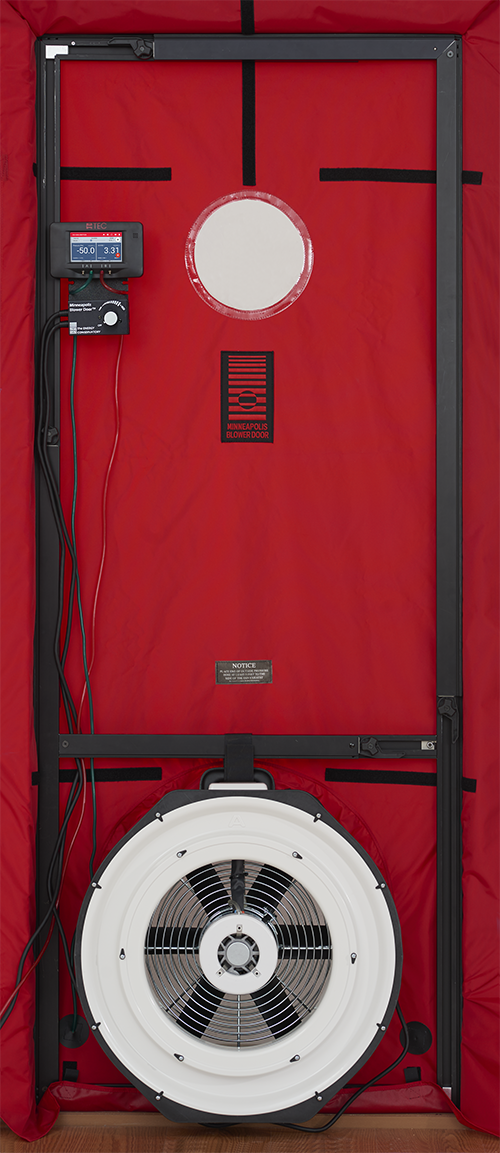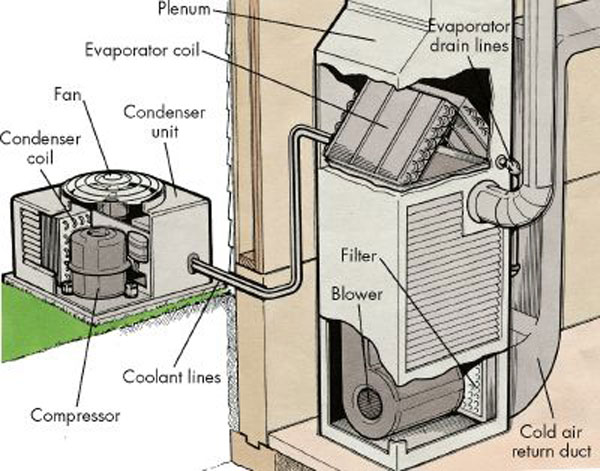|
Air Changes Per Hour
Air changes per hour, abbreviated ACPH or ACH, or air change rate is the number of times that the total air volume in a room or space is completely removed and replaced in an hour. If the air in the space is either uniform or perfectly mixed, air changes per hour is a measure of how many times the air within a defined space is replaced each hour. Perfectly mixed air refers to a theoretical condition where supply air is instantly and uniformly mixed with the air already present in a space, so that conditions such as age of air and concentration of pollutants are spatially uniform. In many air distribution arrangements, air is neither uniform nor perfectly mixed. The actual percentage of an enclosure's air which is exchanged in a period depends on the airflow efficiency of the enclosure and the methods used to ventilate it. These systems range from a conceptual system of perfect displacement, which removes and replaces all air in a space, to a short circuit flow in which very little o ... [...More Info...] [...Related Items...] OR: [Wikipedia] [Google] [Baidu] |
Displacement Ventilation
Displacement ventilation (DV) is a room air distribution strategy where conditioned outdoor air is supplied at a low velocity from air supply diffusers located near floor level and extracted above the occupied zone, usually at ceiling height. System design A typical displacement ventilation system, such as one in an office space, supplies conditioned cold air from an air handling unit (AHU) through a low induction air diffuser. Diffuser types vary by applications. Diffusers can be located against a wall ("wall-mounted"), at the corner of a room ("corner-mounted"), or above the floor but not against a wall ("free-standing"). The cool air accelerates because of the buoyancy force, spreads in a thin layer over the floor, reaching a relatively high velocity before rising due to heat exchange with heat sources (e.g., occupants, computers, lights). Absorbing the heat from heat sources, the cold air becomes warmer and less dense. The density difference between cold air and warm air crea ... [...More Info...] [...Related Items...] OR: [Wikipedia] [Google] [Baidu] |
Equilibrium
Equilibrium may refer to: Film and television * ''Equilibrium'' (film), a 2002 science fiction film * '' The Story of Three Loves'', also known as ''Equilibrium'', a 1953 romantic anthology film * "Equilibrium" (''seaQuest 2032'') * ''Equilibrium'', short film by Steven Soderbergh, a segment of ''Eros'' * "Equilibrium" (''Star Trek: Deep Space Nine''), Star Trek DS9 Episode 4, Season 3 Music * Equilibrium (band), a folk metal band from Germany * ''Equilibrium'' (Crowbar album), 2000 * ''Equilibrium'' (Erik Mongrain album), 2008 * ''Equilibrium'' (God Forbid album), 2012 * ''Equilibrium'' (Whitecross album), 1995 * ''Equilibrium'' (Matthew Shipp album), 2003 * '' IX Equilibrium'', a 1999 album by Emperor * ''Equilibrium'', an album by Fergie Frederiksen Natural sciences * Chemical equilibrium * Equilibrium chemistry * Equilibrium point of differential equations * Mechanical equilibrium * Thermodynamic equilibrium Social sciences * Cognitive equilibration in psych ... [...More Info...] [...Related Items...] OR: [Wikipedia] [Google] [Baidu] |
Volume
Volume is a measure of regions in three-dimensional space. It is often quantified numerically using SI derived units (such as the cubic metre and litre) or by various imperial or US customary units (such as the gallon, quart, cubic inch). The definition of length and height (cubed) is interrelated with volume. The volume of a container is generally understood to be the capacity of the container; i.e., the amount of fluid (gas or liquid) that the container could hold, rather than the amount of space the container itself displaces. By metonymy, the term "volume" sometimes is used to refer to the corresponding region (e.g., bounding volume). In ancient times, volume was measured using similar-shaped natural containers. Later on, standardized containers were used. Some simple three-dimensional shapes can have their volume easily calculated using arithmetic formulas. Volumes of more complicated shapes can be calculated with integral calculus if a formula exists for the shape ... [...More Info...] [...Related Items...] OR: [Wikipedia] [Google] [Baidu] |
Cubic Meters Per Hour
The cubic metre (in Commonwealth English and international spelling as used by the International Bureau of Weights and Measures) or cubic meter (in American English) is the unit of volume in the International System of Units (SI). Its symbol is m3. Bureau International de Poids et Mesures.Derived units expressed in terms of base units". 2014. Accessed 7 August 2014. It is the volume of a cube with edges one metre in length. An alternative name, which allowed a different usage with metric prefixes, was the stère, still sometimes used for dry measure (for instance, in reference to wood). Another alternative name, no longer widely used, was the kilolitre. Conversions : A cubic metre of pure water at the temperature of maximum density (3.983 °C) and standard atmospheric pressure (101.325 kPa) has a mass of , or one tonne. At 0 °C, the freezing point of water, a cubic metre of water has slightly less mass, 999.85 kilograms. A cubic metre is sometimes abbreviated ... [...More Info...] [...Related Items...] OR: [Wikipedia] [Google] [Baidu] |
Rules Of Thumb
In English, the phrase ''rule of thumb'' refers to an approximate method for doing something, based on practical experience rather than theory. This usage of the phrase can be traced back to the 17th century and has been associated with various trades where quantities were measured by comparison to the width or length of a thumb. An erroneous folk etymology began circulating in the 1970s falsely connecting the origins of the phrase "rule of thumb" to legal doctrine on domestic abuse. The error appeared in a number of law journals, and the United States Commission on Civil Rights published a report on domestic abuse titled "Under the Rule of Thumb" in 1982. Some efforts were made to discourage the phrase, which was seen as taboo owing to this false origin. During the 1990s, several authors correctly identified the spurious folk etymology; however, the connection to domestic violence was still being cited in some legal sources into the early 2000s. Origin and usage The exact or ... [...More Info...] [...Related Items...] OR: [Wikipedia] [Google] [Baidu] |
Building Airtightness
Building airtightness (also called envelope airtightness) can be defined as the resistance to inward or outward air leakage through unintentional leakage points or areas in the building envelope. This air leakage is driven by differential pressures across the building envelope due to the combined effects of Stack effect, stack, external wind and mechanical ventilation systems. Airtightness is the fundamental building property that impacts Infiltration (HVAC), infiltration and exfiltration (the uncontrolled inward and outward leakage of outdoor air through cracks, interstices or other unintentional openings of a building, caused by pressure effects of the wind and/or stack effect).M. Limb, "Technical note Air Infiltration and Ventilation Centre, AIVC 36- Air Infiltration and Ventilation Glossary," International Energy Agency energy conservation in buildings and community systems programme, 1992 An airtight building has several positive impacts when combined with an appropriate ventil ... [...More Info...] [...Related Items...] OR: [Wikipedia] [Google] [Baidu] |
Blower Door
A blower door is a machine used to perform a building air leakage test. It can also be used to measure airflow between building zones, to test ductwork airtightness and to help physically locate air leakage sites in the building envelope. There are three primary components to a blower door: a calibrated, variable-speed Centrifugal fan, blower or Fan (machine), fan, capable of inducing a range of airflows sufficient to pressurize and depressurize a variety of building sizes; a pressure measurement instrument, called a manometer, to simultaneously measure the pressure differential induced across the face of the fan and across the building envelope, as a result of fan airflow; and a mounting system, used to mount the fan in a building opening, such as a door or a window. Airtightness testing is usually thought of in residential settings. It is becoming more common in commercial settings. The General Services Administration (GSA) requires testing of new US federal government buildi ... [...More Info...] [...Related Items...] OR: [Wikipedia] [Google] [Baidu] |
Infiltration (HVAC)
Infiltration is the unintentional or accidental introduction of outside air into a building, typically through cracks in the building envelope and through use of doors for passage. Infiltration is sometimes called air leakage. The leakage of room air out of a building, intentionally or not, is called exfiltration. Infiltration is caused by wind, negative pressurization of the building, and by air buoyancy forces known commonly as the stack effect. Infiltration measures The infiltration rate is the volumetric flow rate of outside air into a building, typically in cubic feet per minute (CFM) or liters per second (LPS). The air exchange rate, (''I''), is the number of interior volume air changes that occur per hour, and has units of 1/h. The air exchange rate is also known as air changes per hour (''ACH''). ACH is the hourly ventilation rate, divided by the building volume. It can be calculated by multiplying the building's CFM by 60, and then dividing by the building volume. ... [...More Info...] [...Related Items...] OR: [Wikipedia] [Google] [Baidu] |
Passive House
Passive house () is a voluntary standard for energy efficiency in a building that reduces the building's carbon footprint. Conforming to these standards results in ultra-low energy buildings that require less energy for space heating or cooling. A similar standard, MINERGIE-P, is used in Switzerland. Standards are available for residential properties, and several office buildings, schools, kindergartens and a supermarket have also been constructed to the standard. Energy efficiency is not an attachment or supplement to architectural design, but a design process that integrates with architectural design. Although it is generally applied to new buildings, it has also been used for renovations. In 2008, estimates of the number of passive house buildings around the world ranged from 15,000 to 20,000 structures. In 2016, there were approximately 60,000 such certified structures of all types worldwide. The vast majority of passive house structures have been built in German-speak ... [...More Info...] [...Related Items...] OR: [Wikipedia] [Google] [Baidu] |
Industrial Hygiene
Occupational hygiene or industrial hygiene (IH) is the anticipation, recognition, evaluation, control, and confirmation (ARECC) of protection from risks associated with exposures to hazards in, or arising from, the workplace that may result in injury, illness, impairment, or affect the well-being of workers and members of the community. These hazards or stressors are typically divided into the categories biological, chemical, physical, ergonomic and psychosocial. The risk of a health effect from a given stressor is a function of the hazard multiplied by the exposure to the individual or group. For chemicals, the hazard can be understood by the dose response profile most often based on toxicological studies or models. Occupational hygienists work closely with toxicologists (see Toxicology) for understanding chemical hazards, physicists (see Physics) for physical hazards, and physicians and microbiologists for biological hazards (see Microbiology, Tropical medicine, Infectio ... [...More Info...] [...Related Items...] OR: [Wikipedia] [Google] [Baidu] |
Heating, Ventilation, And Air Conditioning
Heating, ventilation, and air conditioning (HVAC ) is the use of various technologies to control the temperature, humidity, and purity of the air in an enclosed space. Its goal is to provide thermal comfort and acceptable indoor air quality. HVAC system design is a subdiscipline of mechanical engineering, based on the principles of thermodynamics, fluid mechanics, and heat transfer. "Refrigeration" is sometimes added to the field's abbreviation as HVAC&R or HVACR, or "ventilation" is dropped, as in HACR (as in the designation of HACR-rated circuit breakers). HVAC is an important part of residential structures such as single family homes, apartment buildings, hotels, and senior living facilities; medium to large industrial and office buildings such as skyscrapers and hospitals; vehicles such as cars, trains, airplanes, ships and submarines; and in marine environments, where safe and Sick building syndrome, healthy building conditions are regulated with respect to temperature and ... [...More Info...] [...Related Items...] OR: [Wikipedia] [Google] [Baidu] |




